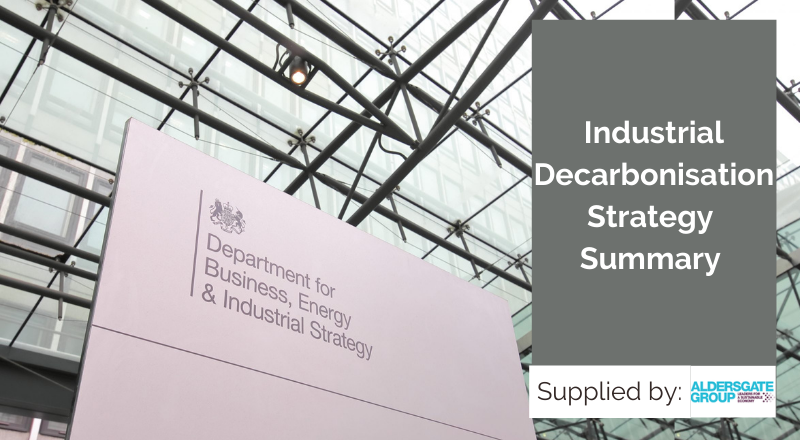The Industrial Decarbonisation Strategy offers a positive direction and comprehensive take on the measures that need to be put in place to help the sector decarbonise in a way that boosts competitiveness and innovation. However, there is no clear sense of what the next steps are in terms of innovation funding support over the coming years or whether government thinks that current funding support is sufficient.
Following the publication of the Industrial Decarbonisation Strategy on Wednesday 17 March, we welcome the summary of key announcements prepared by our partners Aldersgate Group.
The Industrial Decarbonisation Strategy offers a positive direction and comprehensive take on the measures that need to be put in place to help the sector decarbonise in a way that boosts competitiveness and innovation. However, there is no clear sense of what the next steps are in terms of innovation funding support over the coming years or whether government thinks that current funding support is sufficient.
Generally, the Strategy announces limited new grants or funding schemes to support the level of ambition described. In addition, a lot of the measures (e.g. implementation of product standards, the level of free allowances under UK ETS) will be the subject of upcoming consultations, which can influence the implementation timelines and final level of ambition.
The level of ambition is a bit lower than what the CCC recommends (the Strategy commits to at least 2/3 emissions reductions by 2035, whereas the CCC recommends a reduction of 78% in their Sixth Carbon Budget).
Key timelines
The complete summary can be accessed below.
The Industrial Decarbonisation Strategy offers a positive direction and comprehensive take on the measures that need to be put in place to help the sector decarbonise in a way that boosts competitiveness and innovation. However, there is no clear sense of what the next steps are in terms of innovation funding support over the coming years or whether government thinks that current funding support is sufficient.
Generally, the Strategy announces limited new grants or funding schemes to support the level of ambition described. In addition, a lot of the measures (e.g. implementation of product standards, the level of free allowances under UK ETS) will be the subject of upcoming consultations, which can influence the implementation timelines and final level of ambition.
The level of ambition is a bit lower than what the CCC recommends (the Strategy commits to at least 2/3 emissions reductions by 2035, whereas the CCC recommends a reduction of 78% in their Sixth Carbon Budget).
Key timelines
- The design of a net zero-aligned ETS will commence this year, but according to the Strategy the cap on allowances will be aligned with net zero by January 2024. A consultation on the cap, sectors covered and free allowances will be published later this year.
- Two carbon capture clusters will be in place by 2025, with two more by 2030 and the world’s first net zero cluster achieved by 2040, through the £1 billion CCS Infrastructure Fund, as announced in the Ten Point Plan. Hydrogen will be rolled out alongside CCS in these clusters.
- By 2050, the aim is to have zero avoidable waste of materials across heavy industries.
- Four major industrial regions will be linked to the necessary decarbonisation infrastructure by 2030 (i.e. hydrogen or CCUS networks where applicable, otherwise ensuring that the infrastructure needed for electrification is in place). Tackling residual emissions: 3MtCO2 of emissions captured each year by 2030 (CCC recommends CCS reductions of 6MtCO2 per year in 2035, increasing to 9 MtCO2 by 2045), in addition to planting 500m trees.
- Fuel switching with hydrogen, electricity and bioenergy replacing fossil fuels, unless combined with CCS – 20 TWh / year of fossil fuel use will be replaced with low carbon alternatives by 2030.
- Achieving ‘maximum energy, resource and material efficiency’ in industry. Some consultations will be announced (further details below), but no clear measures to deliver that in the strategy itself.
- Developing a market for low carbon materials.
- Supporting workers to take advantage of this transition.
- Cooperate with other nations in support of these efforts.
The complete summary can be accessed below.











